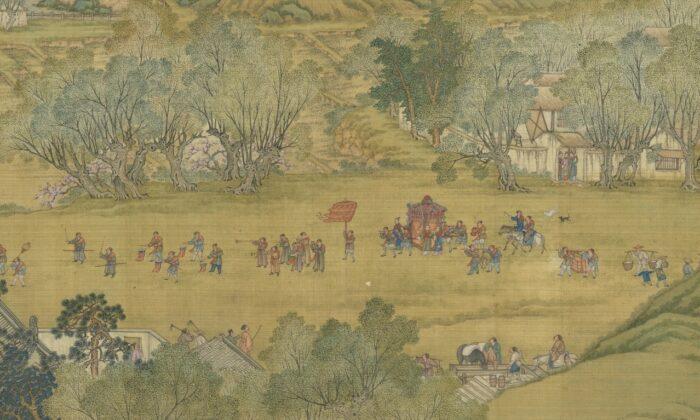Jade is a beautiful stone that suggests water-like fluidity and kindness. Beyond its delicate yet firm texture, it embodies thousands of years of Chinese culture. One can get a sense of Chinese people’s long-lasting admiration for the luster and brilliance of jade through children’s names, poetry, literature, and paintings.
A Tale of Jade From the Neolithic
In Chinese legend, Gong Gong, the lord of water, was defeated in an epic battle with Zhu Rong, the lord of fire. Feeling disgraced and furious, Gong Gong destroyed one of the pillars maintaining balance and stability in the universe. The earth collapsed, with chaos and disasters sending humans into endless misery. Nuwa, the mother of all humans, was saddened by this tragedy. She fused together five-colored stones to patch up the hole in the sky and rescue mankind. The remainder of the stones were scattered abroad into all kinds of jade. This is the origin of jade’s sacred and noble status in Chinese culture.
In an ancient Chinese legend, the goddess Nuwa mended the sky with five-colored stones. This story, passed down for generations, is the origin of jade’s sacred and noble status in Chinese culture. Qing Dynasty, "The Goddess Nuwa Mends the Heavens," by Xiao Yuncong (1596–1673). Public Domain
The finest-quality jadeite can endure extreme heat, pressure, and erosion. Its strength, personified as fortitude, was recognized by our ancestors in the Neolithic Age. In ancient China, people regarded jade as a medium of communication with the divine and an embodiment of virtue, including truthfulness, purity, propriety, and benevolence.
In traditional Chinese culture, people use jade to describe men with noble character. Jade is firm and composed; it can even gleam through dirt and dust. Its purity and virtues can be revealed through carving and polishing.

This large jade ring from the Qing Dynasty exemplifies the original style that influenced Chinese jewelry like jade bracelets for many years to come. Courtesy of the National Palace Museum
Jade Jewelry in Marriages
A jade bracelet is the simplest and purest type of jade jewelry—free of diamond decorations and dazzling designs. However, its simplicity demands finer raw materials. In the jade industry, bracelets are the most valuable items, ranking above all other pieces. When craftsmen see a new piece of jade, they first inspect the cracks and colors in the rock. Then they can decide the size of the bracelet. Finally, the remainder of the rock can be used for other jewelry. Jade weighing 22 pounds (10 kilograms) can be made into dozens of jade pendants, but such an amount can hardly be made into two bracelets. Hence, jade bracelets are rare pieces.Jade bracelets were precious gifts and keepsakes in ancient China. Lines from an ancient Chinese poem indicate that jade bracelets symbolize everlasting love and commitment: “How shall we endure parting? The jade bracelets circling our wrists.” Jade bracelets were a common family heirloom and dowry. Mothers gave the bracelets to their daughters or daughters-in-law for good fortune and blessings. Though the custom has faded over time, jade bracelets are still a highly valued gift.

This rope-shaped bracelet is made of Hetian white jade and is currently preserved in Taiwan’s National Palace Museum. Courtesy of the National Palace Museum
Jade’s Qualities Embody Human Virtue
Nowadays, though jade bracelets are rarely used as a token of love, they are still popular jewelry pieces among women for their soothing texture and brilliance. It is believed that a person who wears jade jewelry is gentle and elegant. Among Chinese people, Hetian jade and Fei Cui are two of the most widely appreciated types.Hetian jade is soft yet dense. Of this type, “mutton-fat” jade is the most valuable. It is found in small quarries that have been eroded by rivers flowing from mountains for thousands of years. Its purity, beauty, and endurance against erosion are celebrated. Women who wear mutton-fat jade jewelry are believed to have jade-like gentleness and endurance.
Fei Cui (jadeite), the king of jade, has the beauty of both jade and diamond. Its namesake bird has either flamboyant red feathers or emerald-green feathers. Fei Cui varies in thickness, intensity, evenness, and color. Its colors include white, green, red, purple, orange, yellow, brown, and black and have come to represent diverse beauty and personalities.

Jadeite bracelet, Qing Dynasty (1644–1911). Though Fei Cui jade comes in several colors, it is extremely rare to find three colors present in a single piece. This stunning tricolored jade bracelet symbolizes blessings, fortunes, and longevity. Courtesy of the National Palace Museum
The pure and transparent green Fei Cui, or emperor green, is the most precious jade of all. It symbolizes energy, integrity, and hope. The empress dowager Cixi and Soong May-ling, first lady of the Republic of China, owned valuable jade bracelets.

These emerald-green bracelets were made from the same piece of Fei Cui jade. As a pair, they represent faithful love and remind us that good things come in pairs.
One’s choice of jade can be an indication of one’s personality. As the old saying goes, jade is both soft and firm, subtle and eye-catching. Since the size cannot be adjusted once made into a bracelet, the customer does not get to select the bracelet. Instead, it is the jade bracelet that chooses its owner.

Part of "Buddha of Medicine Bhaishajyaguru (Yaoshi Fo)," by unknown artist, A.D. 762–827, Mid-Tang Dynasty. This part of the wall painting is from the Mogao Caves, also known as Caves of the Thousand Buddhas, cave 112. The Buddhas all wear traditional ornaments made of gold, silver, and jade around their necks. Public Domain
Chinese people believe that jade jewelry is refined by wearing it, and it can in turn refine the wearer. The divine rock can wash away the dust in the corners of one’s mind and bring tranquility. Jade’s purity and simplicity do not fade with time, but bless one’s life with its warmth and gentleness.
This article by Ann Lin was translated by Anne Scott.


